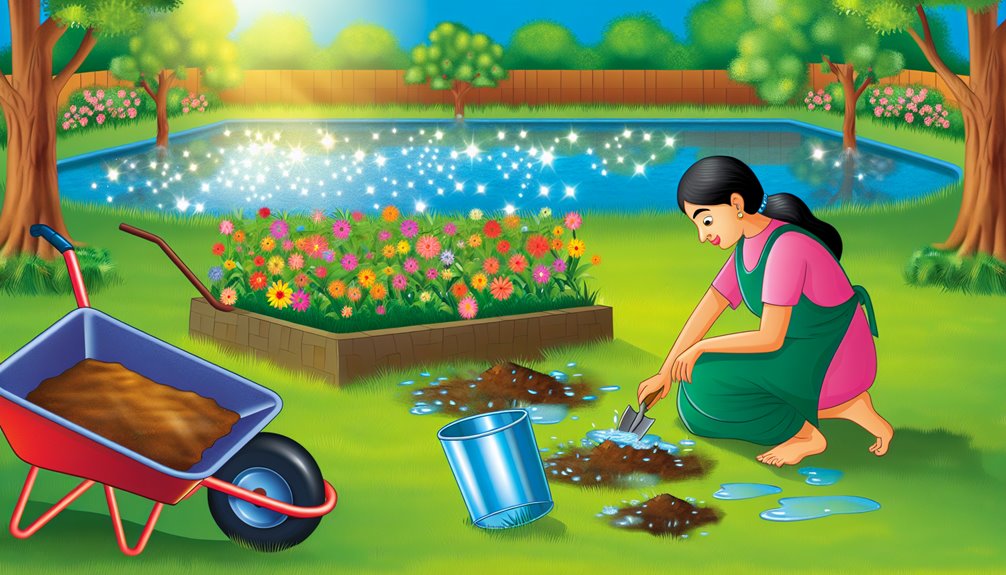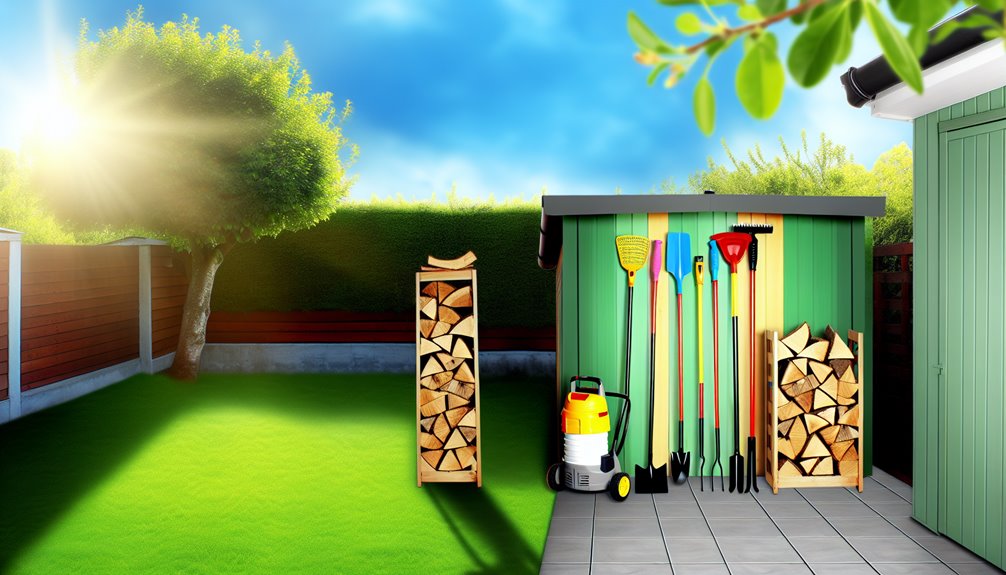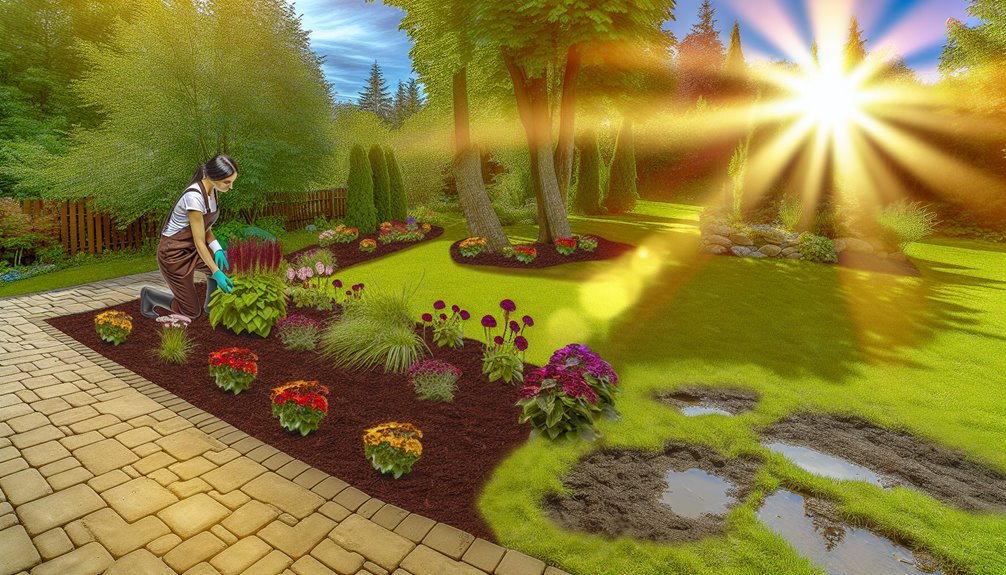If you want your mosquito treatment to work, prep your yard like a pro. You’ll target larvae by dumping standing water, clearing clogged gutters, and thinning dense vegetation to boost airflow and sunlight. Remove damp debris, refresh mulch lightly, and improve drainage to cut breeding sites. Shift furniture and toys for full coverage, protect pets and sensitive plants, and time irrigation and service with the weather. Done right, you’ll reduce rebound populations—and the next steps matter even more.
Identify and Eliminate Standing Water Hotspots

Before you treat the yard, map every source of stagnant water, since mosquitoes can develop from egg to adult in as little as 7–10 days. Systematically inspect standing water sources: buckets, birdbaths, plant saucers, toys, tarps, wheelbarrows, tires, pet bowls, sump cover rims, patio drains, and low lawn depressions. Empty, scrub, and dry containers; refill birdbaths every 48 hours. Level soil to remove puddling. Drill drainage holes in storage bins. Store items upside down. Treat unavoidable water (e.g., ornamental ponds) with EPA-registered Bti dunks per label. Wear gloves, eye protection, and wash hands. Document actions to verify reduced mosquito breeding and protect neighbors.
Clear Clogged Gutters and Downspouts
After eliminating ground-level water sources, address elevated reservoirs—gutters and downspouts routinely hold nutrient-rich, shaded water that breeds mosquitoes unnoticed. Prioritize gutter maintenance on a dry day. Wear cut‑resistant gloves and eye protection. Secure your ladder on level ground; maintain three points of contact. Remove debris with a scoop, then flush channels using a hose to verify continuous flow. Perform downspout inspection: detach elbows if needed, clear obstructions with a plumber’s snake, and confirm discharge away from the foundation. Repair sagging hangers to prevent pooling. Install fine-mesh gutter guards where appropriate. Recheck after storms; consistent upkeep disrupts larval development between treatments.
Tidy Yard Debris and Clutter That Harbor Moisture

Across the yard, target debris and clutter that trap moisture—these create microhabitats where mosquito eggs and larvae thrive. Collect leaves, grass thatch, and fallen fruit; bag and remove them promptly. Flip buckets, toys, plant saucers, and wheelbarrows so water can’t pool. Use debris removal strategies: drill drainage holes in outdoor bins, elevate firewood on racks, and store tarps dry and folded. Rinse and dry recycling before staging. Inspect patio furniture frames and hollow ornaments; empty and wipe them. Apply moisture prevention tips: maintain gravel under faucets, repair leaky spigots, and keep compost balanced and aerated. Wear gloves and eye protection.
Trim Overgrown Vegetation and Low-Hanging Branches
With standing water sources minimized, reduce shade and airflow barriers that let adult mosquitoes rest. Use evidence-based pruning techniques to open dense canopies, elevate low limbs, and thin shrubs to 12–18 inches above ground. This increases sunlight and wind exposure, disrupting harborage sites and improving treatment penetration. Wear cut-resistant gloves, eye protection, and stabilize ladders. Disinfect tools to prevent disease spread between plants. Favor plant selection with airy habits and fewer dense leaf clusters to maintain permeability.
- Target crossed, rubbing, and interior branches first.
- Maintain clearance around walkways and seating.
- Remove sucker growth promptly.
- Schedule trims outside nesting periods.
Refresh Mulch and Adjust Landscaping for Drainage

Although pruning opens air and light, you still need to manage ground moisture so larvae can’t develop and adults don’t shelter at the soil line. Refresh compacted beds with thin layers and choose mulch types that drain: shredded hardwood or pine bark outperform impermeable sheets. Maintain 2–3 inches; pull mulch back 6 inches from foundations and trunks to reduce damp harborage. Correct landscape slopes to move water away from structures and low pockets. Add soil or gravel to eliminate depressions; use French drains where runoff concentrates. After rain, verify infiltration within 24–48 hours. Wear gloves and an N95 when disturbing moldy mulch.
Prepare Water Features and Birdbaths the Smart Way
You’ve managed soil moisture and drainage; now address standing water you keep on purpose. Prioritize water source preparation that protects wildlife and guests. Empty birdbaths every 48–72 hours, scrub biofilm, and refill with fresh water. For ponds, run pumps continuously; moving water disrupts mosquito breeding. Where fish are appropriate, stock mosquito-eating species per local guidance. Apply Bti dunks as labeled; they target larvae without harming birds, pets, or pollinators—core mosquito prevention strategies.
- Replace cracked basins that trap residual water.
- Clean filters; confirm adequate turnover rates.
- Trim vegetation at edges to improve airflow and sunlight.
- Document maintenance dates for consistency.
Manage Irrigation Timing Before and After Service
Because irrigation schedules influence both mosquito biology and product performance, adjust watering 24–48 hours before and after treatment. Pause your irrigation schedule so leaves and mulch dry; residuals bind better to dry surfaces and aren’t washed off. Prioritize moisture management by fixing leaks, shortening runtimes, and directing emitters away from foundations, shady beds, and dense groundcovers where adults rest. If heat stress is a concern, water deeply 48 hours prior, then hold. After service, resume light, targeted cycles—avoid overhead spray on treated foliage for two days. Document run times and zones to guarantee consistency, protect pollinator areas, and safeguard children and pets.
Move Outdoor Furniture and Toys for Better Coverage
Two simple moves—clearing and clustering—improve treatment access and residual coverage. Before technicians arrive, move furniture off shaded edges and under eaves so spray contacts vertical surfaces where mosquitoes rest. Arrange toys into a single zone, elevating items to expose undersides and drain points. You’ll reduce harborage and guarantee even deposition, which studies link to longer residual efficacy.
- Relocate chairs, tables, and bins 3–5 feet from fences and hedges to open spray lanes.
- Group and tilt toys to eliminate water pockets and reveal seams.
- Flip cushions and rinse debris from frames.
- After drying, return items thoughtfully to support family use and community hosting.
Secure Pets, Cover Grills, and Protect Sensitive Plants
With furniture staged for clear spray lanes, address safety controls next: keep pets indoors or in a closed garage with water until surfaces are dry, and notify anyone with access gates to prevent entry during application. Prioritize pet safety by removing bowls and toys, then ventilate kennels after treatment. For grill protection, cool equipment fully, close propane valves, disconnect fuel if applicable, and wrap cooktops, grates, and side tables with food-safe plastic or foil. Safeguard plant care: cover edibles and sensitive ornamentals with breathable fabric, water soil beforehand to reduce uptake, and remove covers after drying. Dispose of contaminated coverings properly.
Coordinate Treatment Timing With Weather and Activity Patterns
Before you mix or spray, check weather and site activity to maximize efficacy and minimize drift and exposure. Align timing strategies with mosquito behavior and your household’s routine. Aim for dawn or dusk when adults rest on foliage, wind is calmer, and temperatures are moderate. Integrate weather considerations: avoid rain within 24 hours, wind above 10 mph, and temperatures over 90°F to prevent volatilization and off-target movement.
- Target calm, cool periods; verify wind at 2–7 mph.
- Schedule when children, pets, and neighbors are indoors.
- Pause for rain forecasts; allow full dry time.
- Document results to refine subsequent applications.
Conclusion
I’m thrilled that you’ve taken these important steps to prepare your yard for effective mosquito treatment! At Mosquito Eliminators of South MS, we understand how vital it is to create a safe and enjoyable outdoor space for you and your loved ones. By following these tips, you’re not just reducing mosquito populations; you’re also contributing to a healthier environment. If you have any questions or want to learn more about how we can help, I invite you to visit us at mosquitoeliminatorsms.com or give us a call at (601) 336-2277. Together, we can make your outdoor experience more pleasant and mosquito-free!

